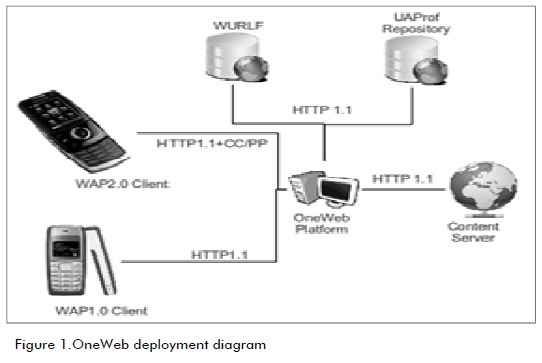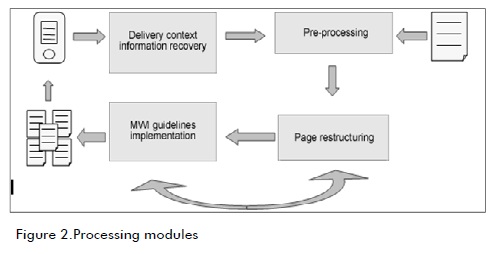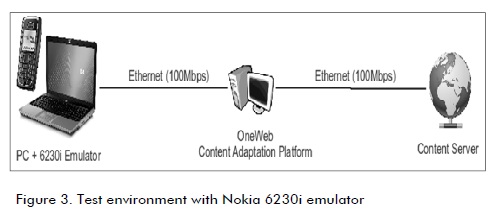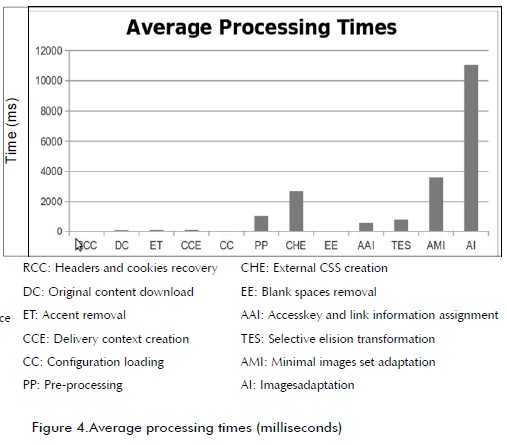Services on Demand
Journal
Article
Indicators
-
 Cited by SciELO
Cited by SciELO -
 Access statistics
Access statistics
Related links
-
 Cited by Google
Cited by Google -
 Similars in
SciELO
Similars in
SciELO -
 Similars in Google
Similars in Google
Share
Ingeniería e Investigación
Print version ISSN 0120-5609
Ing. Investig. vol.31 no.1 Bogotá Jan./Apr. 2011
OneWeb: web content adaptation platform based on W3C Mobile Web Initiative guidelines
Francisco O. Martínez P.1, Gustavo A. Uribe G.2,Fabián L. Mosquera P.3
1 M.Sc. in Engineering, Universidad del Cauca. Researcher Professor, Telematic Engineering Group, Telematic Department, Universidad del Cauca, Colombia. formati@unicauca.edu.co
2 Electronic and Telecomunications Engineer, Universidad del Cauca. PhD Student in Telematic Engineering, Universidad del Cauca, Colombia. guribe@unicauca.edu.co
3 Electronic and Telecomunications Engineer, Universidad del Cauca. Development Engineer, Universidad del Cauca, Colombia. zadinoel@gmail.com
ABSTRACT
Restrictions regarding navigability and user-friendliness are the main challenges the Mobile Web faces to be accepted worldwide. W3C has recently developed the Mobile Web Initiative (MWI), a set of directives for the suitable design and presentation of mobile Web interfaces. This article presents the main features and functional modules of OneWeb, an MWI-based Web content adaptation platform developed by Mobile Devices Applications Development Interest Group’s (W@PColombia) research activities,forming part of the Universidad de Cauca’s Telematics Engineering Group. Some performance measurement results and comparison with other Web content adaptation platforms are presented. Tests have shown suitable response times for Mobile Web environments; MWI guidelines were applied to over twenty Web pages selected for testing purposes.
Keywords: Delivery context, MWI, Mobile Web, navigability.
Received: December 15th 2009. Accepted: January 15th 2011
Introduction
Anywhere-, anytime-connectivity and the large number of Webenabled mobile devices have made the mobile Web become an essential component for Web evolution (Kaikkonen, 2008). In spite of mobile device market growth and internet connection demand, Web navigation from mobile devices still remains impractical (Comscore, 2009;Shrestha, 2007). Some intrinsic restrictions on mobile devices such as screen-size, low processing capability, limited keyboards and different support formats, have restricted content providers’ abilities to develop Web sites which can be successfully accessed from whole Web-enabled mobile device families and configurations (Canali et al. 2009).
A comfortable navigation experience is thus very important formaking accessing from multiple devices become a transparent process. Accordingly, W3C (World Wide Web Consortium) has developed a proposal known as the "Mobile Web Initiative" (MWI) as a first step towards a unified Web having accessible content adapted to mobile device capability.
This article introduces the most important features of OneWeb, a Web content adaptation platform for mobile devices which is based on W3C MWI with static and dynamic mechanisms for recovering mobile device features. Likewise, some experimental results are presented showing that MWI guideline implementation does not meaningfully affect response time or adapted content size.
These conclusions were validated by comparison with similar content adaptation systems, considering some aspects such as: adapted content size, MWI guideline implementation and welladapted content; the latter aspect has been considered because some Web pages are not well-adapted, so response only includes a few kilobytes.
The Mobile Web Initiative (MWI)
W3C is a well-known organization which is responsible for several Web standards. W3C has recently developed a proposal known as the "Mobile Web Initiative"(W3C, 2008)which looks for a user-comfortable Web navigation experience from mobile devices (Leiba, 2009)..A "Mobile Web Best Practices" framework is included in MWI for developing some guidelines related to Web and mobile world convergence, according to mobile devices´ implicit restrictions and market fragmentation issues (W3C, 2007). Content providers, Web application developers and content adaptation application developers are involved in such initiative.
Overall behavior
These guidelines are aimed at Web page designers; these principles underlie adapted content delivery to mobile devices. Examples: thematic consistency of resources identified by a URI, pages must be tested on several device families, etc.
Navigation and links
These guidelines are related to hyperlinks and navigation methods, consistent with mobile device capability. Examples: site entry point URIs must be short, having a minimal navigation bar at the top of the page and trade-off between navigation links and hops required to reach what a seris looking for, etc.
Page layout and content
Some guidelines about the Web pages content are proposed; specifically, content creation aspects for intrinsic mobile device restriction adaptation are considered. Examples: multimedia content not easily rendered on mobile devices should be avoided (e.g. high definition images or videos), page size must not exceed 10 Kb without images, content must remain readable, even if there are background images, etc.
Page definition
Some guidelines about aspects related to HTML code and HTTP headers are considered. These aspects do not alter Web page content directly but some presentation elements and performance aspects may be affected. These guidelines look for good Web page definition to improve content adaptation results. Examples: frames and tables should be avoided, relative units on Web page mark up should be used, etc.
User input
Input systems are more restrictive on mobile devices than on desktop computers. These guidelines thus consider typical input restrictions on mobile devices to limit their use in Web site developer designs. Example: free entry text should be avoided, logical order through links, labels must layout properly in relation to the form controls they refer to and "label" tags must be used, etc.
Delivery context
Delivery contexts are the answer to Web content adaptation requirements for every device or owser; they are descriptors for device and/or content user abilities. Dynamic adaptation would be impossible without a delivery context; however, delivery context is not an adaptation process itself (Fang, 2009). Components involved in content request and delivery on the network, such as user agents, Web servers and proxy servers, must support delivery context implementation. The One Web content adaptation platform builds delivery context from three specific sources.
HTTP headers
Nowadays, this is the most popular mechanism for Web content adaptation (Korpipaä, Häkklä, Kela, RonkainenandKänsälä, 2004). HTTP protocol has defined the following headers related to client device features:
"Accept": media or file types accepted by user agent;
"Accept-Char set": char set supported by user agent;
"Accept-Encoding": preferred encoding (compression system) for user agent;
"Accept-Language": language supported for user agent; and
"User-Agent": refers to a owser or client device. Nevertheless, there are no standards about "User-Agent" header information.
UAProf (User Agent Profile)
CCPP (Composite Capability Preference Profile) was built for device capability and user profile description using a set of tags to represent the information; UAProfis the descriptor implementation for WAP mobile devices. Using HTTP headers, a URL is where CCPP device capability information resides (Viana et al., 2005). WAP 1.2.1 suggests HTTP Extension Framework protocol for transport purposes; WAP 2.0 defines W-HTTP as an HTTP 1.1 extension. Vendors build UAProf specifications for their mobile devices to ease Web content adaptation according to device capability. However, this approach has some problems:
1. UAProf is not defined for all mobile devices;
2. Some delays may be perceived during Web owsing;
3. UAProf data is not standard;
4. Bad UAProf header planning leads to errors; and
5. Some vendors define these profiles for device families; they are not defined for every mobile device (WAP Forum, 2007).
WURFL (Wireless Universal Resource File)
This initiative manages an XML configuration file with information about a lot of mobile devices´ capabilities. This information is not provided by vendors; mobile application developers make their contributions to this database because they require the information (Passani, 2007). Luca Passani (OpenWave developer) and Andrea Trasatt (Independent developer, active user of sourceforge.net) managed the project from the beginning to keep an updated repository due to contributions from a large developer community around the world. Lucas Passani developed WALL (Wireless Abstraction Liary), a liary for Web page design and Web content delivery on WML (Wireless Markup Language), C-HTML (Compact Hyper Text Mark up Language) and XHTML (eXtensible Hyper Text Markup Language) Mobile Profile (WAP Forum, 2007) formats, according to mobile device capabilities. The WURLF Project started in2002 and has compiled information about 7,000 devices to date (Missha, 2005).
OneWeb platform
OneWeb is a W3C MWI-based Web content adaptation platform for mobile devices. Figure 1 shows a OneWeb deployment diagram. WAP 1.0 and WAP 2.0 clients send HTTP requests to the OneWeb platform. WAP 2.0 clients add a description of its CCPP delivery context information; OneWeb gets all required information from WURLF and UAProf repositories from previous delivery context data. Once delivery context is complete, the HTTP request is sent to a Web content server; the server response is stored on the platform and adapted according to delivery context data and MWI guidelines. Adapted content is delivered to a client. Although the process is similar for WAP 1.0 clients, context delivery information frequently cannot be extracted from UAProf, and the WURLF repository must therefore be used. WML mark up is used for these clients.

OneWeb has four processing modules to perform the previously described tasks (Figure 2); a configuration file is also available to customize some task performance according to site administrator or application developer criteria.

Two blocks work sequentially, as long as the other modules feedback each other. When these processes are complete, Web content is adapted according to mobile device capability.
Delivery context information recovery
Delivery context is built to known mobile device capabilities and restrictions. The OneWeb content adaptation platform gets the information from the three previously described repositories (HTTP headers, UAProfand WURFL) to create delivery context. Module implementation uses DELI (Delivery Context Liary) liary API.
Pre-processing
Web page content some times has errors in their mark up structure; it makes the Web content adaptation process more complex. A pre-processing phase is there fore required to prepare content for adaptation. Some tasks are performed in this functional module: JavaScript code is written as comment sentences; original comment sentences are removed, unknown tags, HTML 3.2 not supported tags or duplicated tags are also removed. The HTML mark up is adapted to XHTML mark up conventions, using TIDY liary API.
Page restructuring
Tailoring Web content to mobile device capabilities requires restructuring which suggests some transformations (Lee et al., 2006). Selective elision transformation is the first transformation process which analyses whether content structure may be processed by handheld devices; when this is not possible, content structure is destroyed and long texts are connected to hyperlinks which are available when adapted content is owsed. The second transformation process creates a sequence of subpages fitting on small mobile device displays connected by hyperlinks; this process is known as indexed segmentation transformation (Younghyun et al., , 2001). Other tasks include: frame removal, image size compression and HTML mark up translation to WML when required (WAP 1.0 clients).
MWI guideline implementation
Some adjustments are made to Web content pages during this process according to MWI guidelines, such as:<base> tag re moval, text colour correction, <font> tag conversion to cascading styles, external cascading style sheet (CSS) creation, including individual styles in external CSS, auto-load or redirect tag removal, URL hyperlink correction, blank space removal, text field resize according to display support, image map adaptation, colour depth, size compression and image format trans coding according to mobile owser support.
Experimental development
The OneWeb experimental phase was performed according to these essential objectives: evaluating platform performance in every functional module and comparing results with similar Web adaptation content systems. Regarding the latter, system comparison considered the following aspects: adapted content size, MWI guideline implementation and well-adapted content issues.
Platform lab tests were performed using a local area network (Figure 3). Moreover, some emulators and mobile phones were tested: OpenWave V7, Nokia 6230i, OpenWave UP, Nokia 6500, Sony Ericsson K750, WinWAPemulators and Nokia E65, Nokia N90, Nokia E61i, Nokia 6682, Nokia 6230 mobile phones. All tests validated OneWeb platform capability and demonstrated meaningful improvement of Web page navigability.

Twenty Web pages having different content characteristics were selected for testing purposes (see list in Figure 5);Figure 4 shows processing times. It should be understood that OneWeb platform image adaptation did not freeze content delivery; rather, a minimal customized number of images was adapted (5 by default) and then the HTTP response was sent. According to results, external CSS creation, access key and link information assignment and Web page pre-processing tasks required more time to complete by far. Nevertheless, access key and link information assignment time might have been lower if their parameters had been properly customized in the configuration file to turn off external link download.


Figure 5 gives a graphical comparison between OneWeb, Google (Google, 2008) and AOL Mobile (AOL, 2008) platform adapted content size in kilobytes; Google and AOL Mobile platforms were selected from a previous comparison analysis with other content adaptation platforms where they gave the best results. However, none of them supported MWI guidelines. A dot over the "x" axis thus meant the content could not be adapted, such as 9, 10, 18 and 19 cases for AOL platform and 9 and 10 cases for Google. Although page 19 was processed by Google Mobile, it could not be used because image map adaptation using MWI guidelines was not enough. Some images could not be adapted by the Google and AOL platforms which reduced page size; however, these results were very close to OneWeb platform behaviour in the same cases.
The OneWeb platform thus had better behaviour concerning Web page adaptation than Google and AOL Mobile, considering the different content characteristics and categories being evaluated, including e-commerce sites, news, search engines, wikis and so on. On the other hand, although OneWeb implemented MWI guidelines, it demonstrated similar performance regarding well-known adaptation platforms like Google and AOL Mobile.
Conclusions
The OneWeb content adaptation platform ensured navigability, cost reduction and improved user experience throughout dynamic adaptation based on mobile device capability. Comparison test results showed that OneWeb had similar performance regarding other well-known platforms like Google and AOL Mobile. This suggested that MWI guideline implementation on adaptation Web content platforms is a practical mechanism for improving mobile Web user experience. Moreover, the platform represents a first approach to buildingW3C MWI reference implementation; there were no restrictions concerning language and/or device, because international standards were considered.
Otherwise, according to OneWebplatform module performance, it can be confirmed that image compression, indexed segmentation transformation and selective elision transformation hadan important influence oncontent adaptation and reduced Web page size by far. Although processing times were not minimal, they rarely exceeded the waiting times supported by most owsers (30s); processing time was alsowell-balanced because delivery time was reduced when content size was lower. So, intrinsic processing times did not downgrade user navigability experience.
Future work
Mobile Gateway interface
Mobile operators require gateway interface implementation to include OneWeb content adaptation platform.
Web development environment
OneWeb assures the implementation of most MWI guidelines. However, it is difficult to obtain automatic implementation of some recommendations aimed at Web application designers. A Web development environment to ensure such guidelines´ implementation during Web page design time is thus suggested.
Mobile device test platform
Nowadays there are few emulator versions when compared to current mobile device suit which restricts tests of available emulators. A mobile device test platform having well-defined delivery context emulation capability is required to perform tests on a wide range of mobile devices. The platform should be able to obtain third-party delivery context information with edition and update functions.
References
AOL., AOL Mobile Searchplatform, http://mobile.aolsearch.com, [Consulta: Febrero de 2008] [ Links ]
Canali, C., Colajanni, M., Lancellotti, R., Performance Evolution of Mobile Web-Based Services., IEEE Internet Computing,Vol. 13, No. 2, Abr., 2009, pp. 60-68. [ Links ]
Comscore., The Next Big Things: Mobile Internet & Applications - Gaining Momentum., http://www.comscore.com/Press_Events/Press_Releases/2009/3/Daily_Mobile_Internet_Usage_Grows, 2009. [Consulta: 3 de Noviembre de 2009] [ Links ]
Fang, Y.M., Seamless content delivery in the future mobile internet.,IEEE Wireless Communications, Vol. 16, No. 5, Oct.,2009, pp. 2-3. [ Links ]
Google., Google Mobile Search Platform., http://www.google.com/m [Consulta: Febrerode 2008] [ Links ]
Kaikkonen, A., Full or tailored mobile web- where and how do people browse on their mobiles?., ACM Mobility '08, Sep., 2008, pp. 1-8. [ Links ]
Korpipää, P., Häkkilä, J., Kela, J., Ronkainen, S., Känsälä, I., Utilising context ontology in mobile device application personalisation., ACM MUM '04, vol. 83, Oct., 2004, pp. 133-140. [ Links ]
Lee, E., Kang, J., Choi, J., Yang, J., Topic-Specific Web Content Adaptation to Mobile Devices, Web Intelligence., IEEE Computer Society, Dec., 2006, pp. 845-848. [ Links ]
Leiba B., An Introduction to Internet Standards., IEEE Internet Computing, Vol. 12, No. 1, Feb., 2009, pp. 71-74. [ Links ]
Missha., Comentario acerca de WURLF, 2005., http://www.avidos.net/ring/que-es-wurlf/ [Consulta: Febrero de 2007] [ Links ]
Passani, L., Página principal del proyecto WURLF., http://wurfl.sourceforge.net/ [Consulta: Febrero de 2007] [ Links ]
Shrestha, S., Mobile web browsing: usability study., ACM Mobility '07, Sep., 2007, pp. 187-194. [ Links ]
Viana, W., Teixeira, R., Cavalcante, P., Andrade R., Mobile Adapter: Umaabordagem para a construção de Mobile Application Servers adaptativos utilizando as especificações CC/PP e UAProf., http://www.sbc.org.br/bibliotecadigital/download.php?paper=173, Jul. 2005. [ Links ]
W3C Mobile Web Best Practices Working Group., Mobile Web Best Practices 1.0, http://www.w3.org/TR/mobile-bp/ [Consulta: Marzo de 2007] [ Links ].
W3C., W3C Mobile Web Initiative., http://www.w3.org/Mobile/ [Consulta: Abril de 2008] [ Links ].
WAP Forum., WAG UAProf, http://www.openmobilealliance.org/tech/affiliates/wap/wap-248-uaprof-20011020-a.pdf, [Consulta: Abril de 2007] [ Links ].
Wireless Application Protocol Forum, Ltd., XHTML Mobile Profile. http://www.openmobilealliance.org/tech/affiliates/wap/wap-277-xhtmlmp-20011029-a.pdf [Consulta: Marzo de 2007] [ Links ]
Yonghyun, W., Changwoo, J., Jihong, K., Sungkwon, C., WebAlchemist: A Web Transcoding System for Mobile Web Access in Handheld Devices., In: Proc. SPIE, vol. 4534, Oct., 2001, pp. 3-7. [ Links ]











 text in
text in 


